Cynical disappointment. That would have been my judge, jury, and executioner immediate reaction upon entering IndieCade 2014. Sweltering under the intense sun of an unprecedented drought in California, swimming in the midst of the initial shitstorm that was Ye Olde Geat Fram Gamyr, my eyes and my camera darted along the lines of people, along the rows of tents, looking for the worst. Everywhere I saw nothing but signs for PlayStation-this and Nintendo-that; random brightly branded sponsors trying to sell me wireless internet services for a phone I don’t have; expensive, exciting-sounding schools vying to fulfill my dreams. But one of the fascinating paradoxes of visual art is that while a certain flash of emotion might incite an art project, the process of close contact with the unique and specific details that reveals themselves in the process often leads to a completely different point of view than the initial impression.
 Leaving aside all of the other menagerie of lessons learned, unlearned, and still learning from my MFA program, the revelation that stuck with me the most was hammered into me from one infamous class, Post-Studio with (sadly recently passed) Michael Asher. Its premise was simple and has become a maxim for my own art: A project is brought in to share, and everyone in the class talks about it until everyone is totally and completely finished, hours and hours later. Many times I would rail, impassioned, about the work at hand, only to find, hours and hours later in the opposite camp owing to the irreplaceable process of digging past preconceptions and predilections and actually seeing what is in front of you.<--break->
Leaving aside all of the other menagerie of lessons learned, unlearned, and still learning from my MFA program, the revelation that stuck with me the most was hammered into me from one infamous class, Post-Studio with (sadly recently passed) Michael Asher. Its premise was simple and has become a maxim for my own art: A project is brought in to share, and everyone in the class talks about it until everyone is totally and completely finished, hours and hours later. Many times I would rail, impassioned, about the work at hand, only to find, hours and hours later in the opposite camp owing to the irreplaceable process of digging past preconceptions and predilections and actually seeing what is in front of you.<--break->
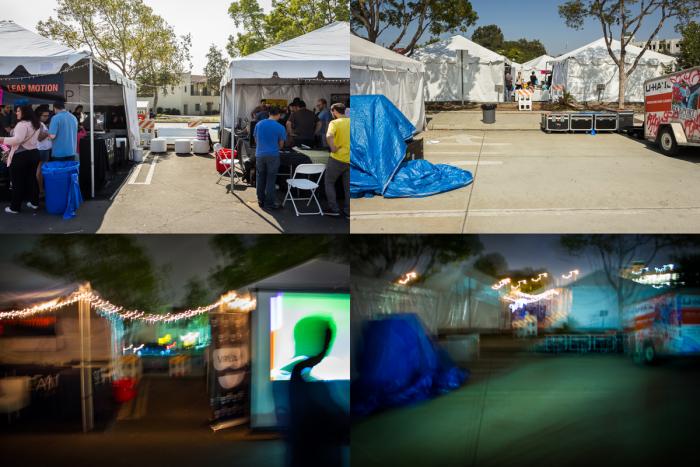
So despite my initial intent to grumble and dismiss I closed my eyes, cleaned my sunglasses, and scanned the asphalt vista again. I turned my camera to studiously scrutinize the very facade that had appalled me. But what would be the best way to try to see what was really there, not just reproduce my current emotional state? Thankfully I’ve been digging deep into Ed Rushca’s photo books, such as Every Building On The Sunset Strip (and the fascinating rediscovered Japanese predecessor), which is a photo book of exactly what the title says. Instead of relying solely on my clearly biased editorial judgment, I decided that it would be fascinating to be as flat-footed as possible and photograph every tent (and for completeness, every space between tents) in the main public event area
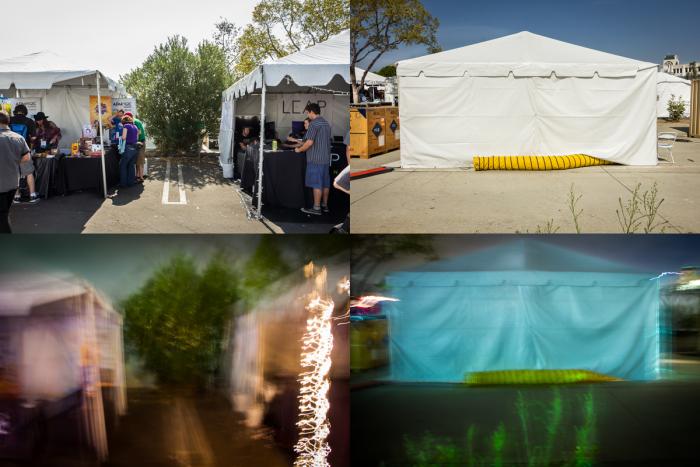
Who knows what you’ll uncover in your own scrutiny and recombination of this photo-matrix, but the longer I photographed the more that it was obvious that these small tents glimmered with a proliferation of multifaceted realities. IndieCade was a world of nested worlds, a world of gaps, a world of dissonant systems, of many webs of internal investigations in progress. Under sustained examination, this space fried by the sun and so ill-suited to art and games at first glance, held a phenomenal amount of rolled-up time. The idea of “rolled-up time” is a strange but apt term used in some communities to describe the strange phenomenon of time that expands to different scale than the actual watch hand. This phenomena is as common as novels that span years but take hours to read, or as rarified as Zen meditation, which is where the term comes from, referring to the meditation mat that could be easily rolled up and carried around, but contained infinity.
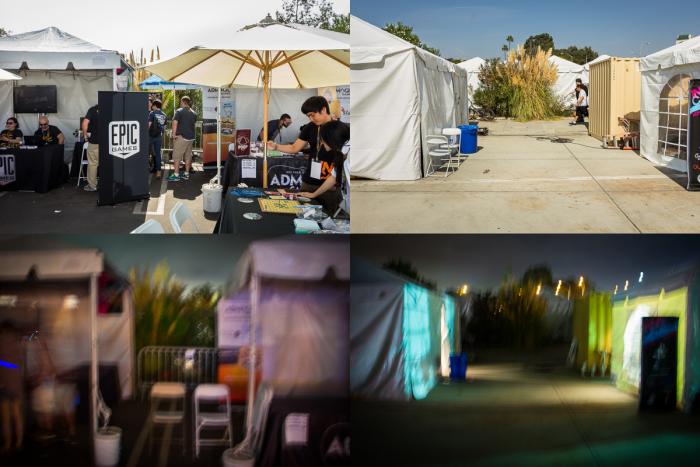
Through the act of plodding along, standing in front of each tent and photographing, I found so many amazing games, and even more amazing people — a universe of wonders packed away and away and away from any initial glance. And in a way, these tents became a metaphor for art more broadly. It is the time spent following along the weaving, wavering, strange trails deep into the shadow realms that tend to be the most meaningful and lasting.
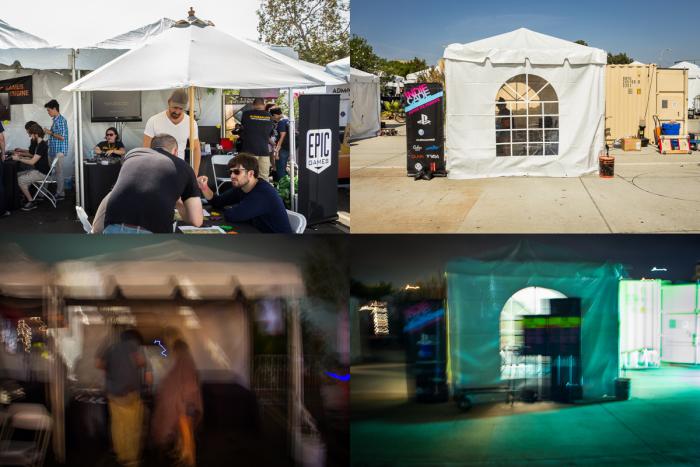
But once the endorphins born of gazing across the nigh-vertigo-inducing vistas of the video game underground flushed out of my system, once I had photographed every tent and gap in the event area, the blistering sun raked across my eyes and I started to feel quite alienated. Not by anything that anyone did, mind you. I was welcomed enthusiastically by both the crowd and creators. Simply put, in my cynicism-turned-euphoria, I had briefly forgotten that I was still an outsider, still a visitor with a camera.

It’s a tricky sensation to describe, and one that might not make sense given that I occasionally write essays on video games. If pressed, I would almost say the sensation is in fact that tinge of jealousy that comes with meeting someone who has a overwhelmingly more vast insider’s knowledge than myself. I would feel just as out of place, if still as fascinated, if I went to a chef’s conference, a cybernetics meet-up, or a Shakespearian sonnet convention. Additionally, my sense of awkwardness was partially also fueled by the fact the whole damn event takes place in walking distance from my apartment. Real life meetings of primary virtual communities are anxiety inducing to start with, but doubly so when they land in your back yard. A yard which, given that I live in a small apartment, is a large public square in my town, ringed by trendy bars, fancy restaurants, organic grocers, and down the street from the Sony Pictures lot. (IndieCade is erected in an open area immediately next door to the old Culver Hotel where the midgets from Wizard of Oz had orgies while shooting that film — a strange piece of trivia you probably didn't want to know). So, rather than try to quash this nigh-paranoid sensation, I kept following along and doubled down on this exact inside/outside relationship. After all, it’s a fairly interesting question to figure out how I had accidentally stumbled in to a strange position where I was somewhat inside and somewhat outside of one of the most exciting media movements in our lifetime. How did each side of myself perceive the other? How might that internal conflict stemming from our Balkanized cultural-media world be expressed in photographs of this video game encampment?
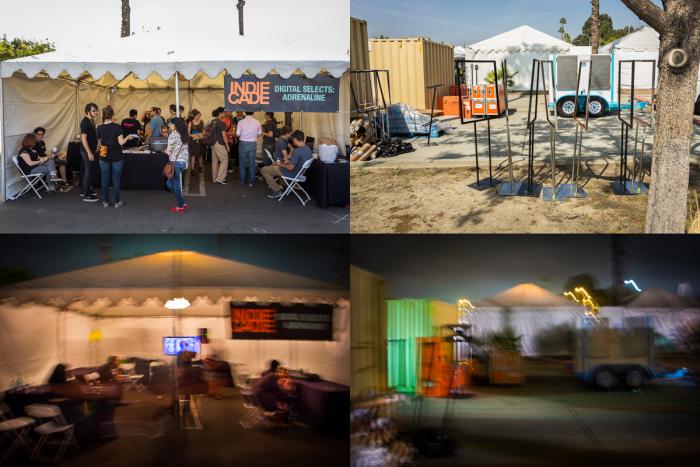
It’s easy to get angsty when faced with the limitations and contradictions of one’s own perception, but it can also be exhilarating to try to create art that contains the multiple. In this way, I decided to augment my initial task of photographing everything from the inside looking outward (the participants’s view) by tucking my badge away for a movement, and moving a handful of feet outside the gate. There I tracked along the same counter-clockwise motion, photographing the opposite side of the tents and gaps, looking in from the literal outsider’s view; from the same place that anyone ambling along to the local grocery store would have to walk. Capturing this disorienting sense of floating both inside and out at once — of media-geography wavering in contradicting multiple viewpoints through a series of user-rearrangeable photo sets — came not from stopping at a predefined idea, but through continuing to follow along my own convoluted and contradictory feelings.
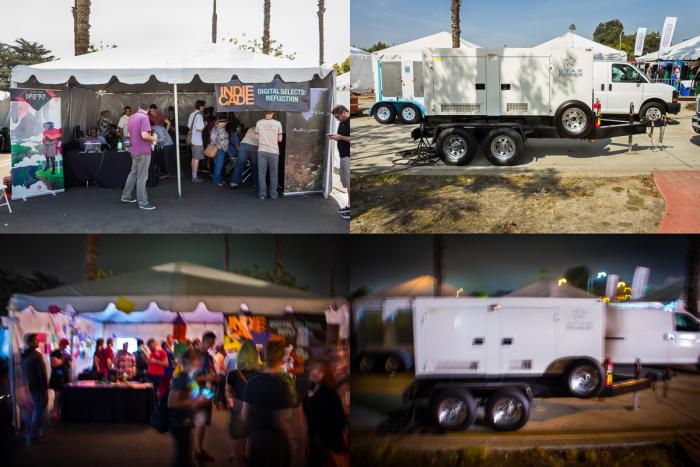
Having gotten rather sunburnt and collected masses of interesting business cards while peering over laptops, I had heard repeated mumbles from veterans that I needed to come back for the chaos of the NightGames event. After hours, this same tent town shut down and transformed into a mirage, a semi-rave-Burning-Man-cyber-punk-inspired menagerie of light, sound and installation. After dropping by another party for a couple beers, I returned to find the fringes of IndieCade’s daytime world had grown to prominence — a wild swirl of chaos, bumping, jostling and glowing people wandering between the installations and performances. From the outside, all you could see were brief, inexplicable fragments of VR goggles, projections, wild costumes, and tents that glowed with stars from the inside. So I did the same operation, photographing each tent (mostly unused, aside from the occasional new couple making out) from the inside and outside, trying with wild lack of success to hand-hold my camera in the darkness with throngs of people swarming around. In keeping with my flat-footed approach, I tried to use the same basic settings on the camera aside from the shutter speed to render the late night adventures. In this way, the images could highlight the way the world feels different depending on if it is illuminated by harsh glare of the desert’s sun or the diffuse glow of the urban night.
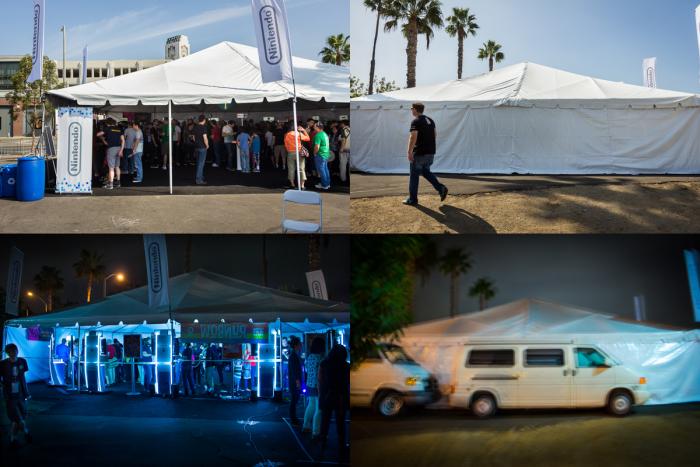
While this project might not be the most objective vision of the oasis that is IndieCade, perhaps it can serve as a multifaceted reminder that the convoluted relationships between inside and outside, between daytime and nighttime, are also contained within each other. The matrix of photographs constantly still presents surpassing combinations and details to me; a perpetual reminder to slow down, to look longer, to understand that the perspective from which I currently view the world is but fleeting.
The complete series can be viewed on Eron's page here.

